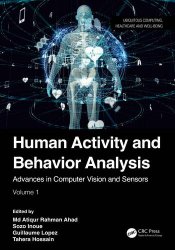Human Activity and Behavior Analysis: Advances in Computer Vision and Sensors: Volume 1
- Добавил: literator
- Дата: 9-03-2024, 04:23
- Комментариев: 0
 Название: Human Activity and Behavior Analysis: Advances in Computer Vision and Sensors: Volume 1
Название: Human Activity and Behavior Analysis: Advances in Computer Vision and Sensors: Volume 1Автор: Atiqur Rahman Ahad, Sozo Inoue, Guillaume Lopez
Издательство: CRC Press
Год: 2024
Страниц: 457
Язык: английский
Формат: pdf (true)
Размер: 21.9 MB
The book discusses topics such as action recognition, action understanding, gait analysis, gesture recognition, behavior analysis, emotion and affective computing, and related areas. This volume focuses on relevant activities in three main subject areas: Healthcare and Emotion, Mental Health, and Nurse Care Records.
Sensors and cameras are exploited for the analysis and recognition of human activity and behavior. In the book Human Activity and Behavior Analysis: Advances
in Computer Vision and Sensors, we have divided across two volumes, 40 wonderful chapters under five parts: Part 1: Healthcare and Emotion (Chapters 1–7), Part 2: Mental Health (Chapters 8–14), Part 3: Nurse Care Records (Chapters 15–26), Part 4: Movement and Sensors (Chapters 27–36), and Part 5: Sports Activity Analysis (Chapters 37–40).
In a complex problem such as stress detection, the application of some type of Machine Learning (ML) algorithms makes sense. The vast amount of data in a context where multiple variables, such as HR, HRV, GSR, and ST, might have different outputs based on each other, makes it a prime target for the ML approach. It is no wonder it has already been applied to it and continues to be used and researched to this day. Machine Learning algorithms are built with data that is fed to them, so it is easy to assume that the quality of the models is proportional to the amount and quality of information that is consumed. To take out any irrelevant information, it is common to apply a pre-processing step known as feature selection, in order to improve the model’s performance. There are a lot of classification algorithms available, however, what dictates whether they perform accurately or not depends on the nature of the given data set and the relationships between data. Some of the most common classification algorithms are Support Vector Machines (SVM), K-Nearest Neighbours (K-NN), Random Forests (RF), Decision Trees, and Naive Bayes (NB). The data processing and model development used different Python libraries such as Pandas, Tensorflow, and Keras. To recognize stress from the physiological data, we tested different Machine Learning algorithms. We implemented the approach using Python and the Scikit-learn library.
Among the teams who opted for the ML pipeline, Random Forest is the most common algorithm followed by Decision Tree and K-Nearest Neighbors. For DL pipelines, team Horizon utilized the Binary Relevance algorithm, Not a Fan of Local Minima implemented Long Short Term Memory Network (LSTM), and DataDrivers_BD used Artificial Neural Network (ANN). Meanwhile, carelab is the only team that opted for K-Means Clustering algorithm with heatmap. To implement the activity recognition model, all the teams have used Python as the primary programming language. Ulster Team has used R as a secondary language while team Horizon, also used Matlab in their method. All nine teams have used Pandas library followed by Numpy, Matplotlib, and Scikit-learn.
Скачать Human Activity and Behavior Analysis: Advances in Computer Vision and Sensors: Volume 1
Внимание
Уважаемый посетитель, Вы зашли на сайт как незарегистрированный пользователь.
Мы рекомендуем Вам зарегистрироваться либо войти на сайт под своим именем.
Уважаемый посетитель, Вы зашли на сайт как незарегистрированный пользователь.
Мы рекомендуем Вам зарегистрироваться либо войти на сайт под своим именем.
Информация
Посетители, находящиеся в группе Гости, не могут оставлять комментарии к данной публикации.
Посетители, находящиеся в группе Гости, не могут оставлять комментарии к данной публикации.
